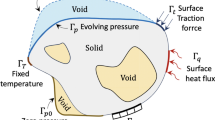For the real time characterization of pultrusion processes with a complex temperature control, two finite-element modeling approaches utilizing a continuous model with lumped material properties for a cured composite have been developed. The first procedure, based on the mixed time integration scheme and the nodal control volumes method, is working in the ANSYS Mechanical environment, but the second procedure is performed using the ANSYS CFX software with the cure reaction introduced as an additional variable. New cure sensors measuring the temperature and electrical resistivity of resins have been developed for the inline process control. To demonstrate the accuracy and reliability of the numerical procedures and new sensors, two technological processes with a temperature control examining the pultrusion of I-beam and rod profiles have successfully been analyzed.













Similar content being viewed by others
References
C. D. Han, D. S. Lee, and H. B. Chin, “Development of a mathematical model for the pultrusion process,” Polym. Eng. and Sci., 26, No. 6, 393-404 (1986).
S. C. Joshi and Y. C. Lam, “Integrated approach for modeling cure and crystallization kinetics of different polymers in 3D pultrusion simulation,” J. Mater. Process. Tech., 174, 178-182 (2006).
P. Carlone, G. S. Palazzo, and R. Pasquino, “Pultrusion manufacturing process development by computational modeling and methods,” Math. Comput. Model., 44, 701-709 (2006).
Y. R. Chachad, J. A. Roux, and J. G. Vaughan, “Three-dimensional characterization of pultruded fiberglass-epoxy composite materials,” J. Reinf. Plast. Comp., 14, 495-512 (1995).
M. Valliappan, J. A. Roux, J. G. Vaughan, and E. S. Arafat, “Die and post-die temperature and cure in graphite/epoxy composites,” Composites: Part B, 27, 1-9 (1996).
I. Baran, C. C. Tutum, and J. H. Hattel, “The effect of thermal contact resistance on the thermosetting pultrusion process,” Composites: Part B, 45, 995-1000 (2013).
R. M. Hackett and S.-Z. Zhu, “Two-dimensional finite-element model of the pultrusion process,” J. Reinf. Plast. Comp., 11, 1322-1351 (1992).
B. R. Suranto, L. Ye, and Y. W. Mai, “Simulation of temperature and curing profiles in pultruded composite rods,” Compos. Sci. Technol., 58, 191-197 (1998).
X. L. Liu, I. G. Crouch, and Y. C. Lam, “Simulation of heat transfer and cure in pultrusion with a general-purpose finite-element package,” Compos. Sci. Technol., 60, 857-864 (2000).
S. C. Joshi and Y. C. Lam, “Three-dimensional finite-element/nodal-control-volume simulation of the pultrusion process with temperature-dependent material properties including resin shrinkage,” Compos. Sci. Technol., 61, 1539-1547 (2001).
I. Baran, J. H. Hattel, and C. C. Tutum, “Thermochemical modeling strategies for the pultrusion process,” Appl. Compos. Mater., 20, 1247-1263 (2013).
P. Carlone, I. Baran, J. H. Hattel, and G. S. Palazzo, “Computational approaches for modeling the multiphysics in pultrusion process,” Adv. Mech. Eng., article ID 301875, 14 P (2013).
E. Barkanov, P. Akishin, N. L. Miazza, and S. Galvez, “ANSYS-based algorithms for a simulation of pultrusion processes,” Mech. Adv. Mater. Struc., 24, No. 5, 377-384 (2017).
Y. R. Chachad, J. A. Roux, J. G. Vaughan, and E. S. Arafat, “Thermal model for three-dimensional irregular shaped pultruded fiberglass composites,” J. Compos. Mater., 30, No. 6, 692-721 (1996).
Z. Ding, S. Li, and L. J. Lee, “Influence of heat transfer and curing on the quality of pultruded composites. II: Modeling and simulation,” Polym. Composites, 23, No. 5, 957-969 (2002).
X.-L. Liu, “Numerical modeling on pultrusion of composite I beam,” Composites: Part A, 32, 663-681 (2001).
W. A. Khan and J. Methven, “Determination of the duty cycle in thermoset pultrusion,” Proc. of 36th Int. MATADOR Conf., London, 75-78 (2010).
J. A. Roux, J. G. Vaughan, R. Shanku, E. S. Arafat, J. L. Bruce, and V. R. Johnson, “Comparison of measurements and modeling for pultrusion of a fiberglass/epoxy I-beam,” J. Reinf. Plast. Comp., 17, No. 17, 1557-1579 (1998).
X. L. Liu and W. Hillier, “Heat transfer and cure analysis for the pultrusion of a fiberglass-vinyl ester I beam,” Compos. Struct., 47, 581-588 (1999).
G. Liang, A. Garg, and K. Chandrashekhara, “Cure characterization of pultruded soy-based composites,” J. Reinf. Plast. Comp., 24, No. 14, 1509-1520 (2005).
I. Tena, M. Sarrionandia, J. Torre, and J. Aurrekoetxea, “The effect of process parameters on ultraviolet cured out of die bent pultrusion process,” Composites: Part B, 89, 9-17 (2016).
P. Akishin, E. Barkanov, N. Miazza, and S. Galvez, “Curing kinetic models of resins for microwave assisted pultrusion,” Key Eng. Mat., 721, 92-96 (2017).
URL: http://www.synthesites.com/ipage.php?p=9&l=11, December 5, 2016.
A. Maffezzoli, A. Trivisano, M. Opalicki, J. Mijovic, and J. M. Kenny, “Correlation between dielectric and chemorheological properties during cure of epoxy-based composites,” J. Mater. Sci., 29, No. 3, 800-808 (1994).
E. Barkanov, P. Akishin, N. L. Miazza, S. Galvez, and N. Pantelelis, “Experimental validation of thermochemical algorithm for a simulation of pultrusion processes,” J. Phys. Conf. Ser., 991, 012009 (2018).
Acknowledgements
The financial support of European Regional Development Fund for the project No. 1.1.1.1/18/A/053 “An effectiveness improvement of conventional pultrusion processes” is acknowledged.
Author information
Authors and Affiliations
Corresponding author
Additional information
Russian translation is published in Mekhanika Kompozitnykh Materialov, Vol. 56, No. 2, pp. 203-224, March-April, 2020.
Rights and permissions
About this article
Cite this article
Barkanov, E., Akishin, P., Namsone, E. et al. Real-Time Characterization of Pultrusion Processes with a Temperature Control. Mech Compos Mater 56, 135–148 (2020). https://doi.org/10.1007/s11029-020-09868-4
Received:
Revised:
Published:
Issue Date:
DOI: https://doi.org/10.1007/s11029-020-09868-4




